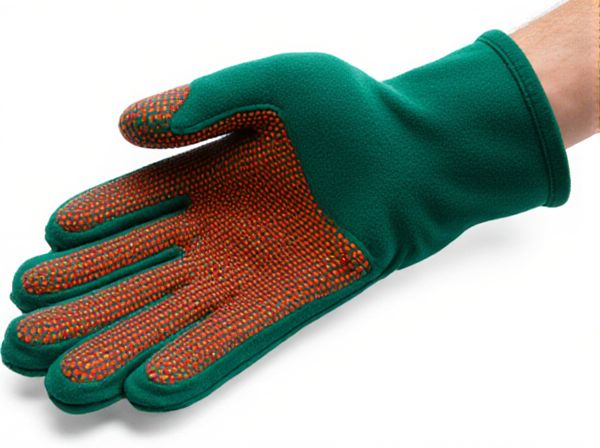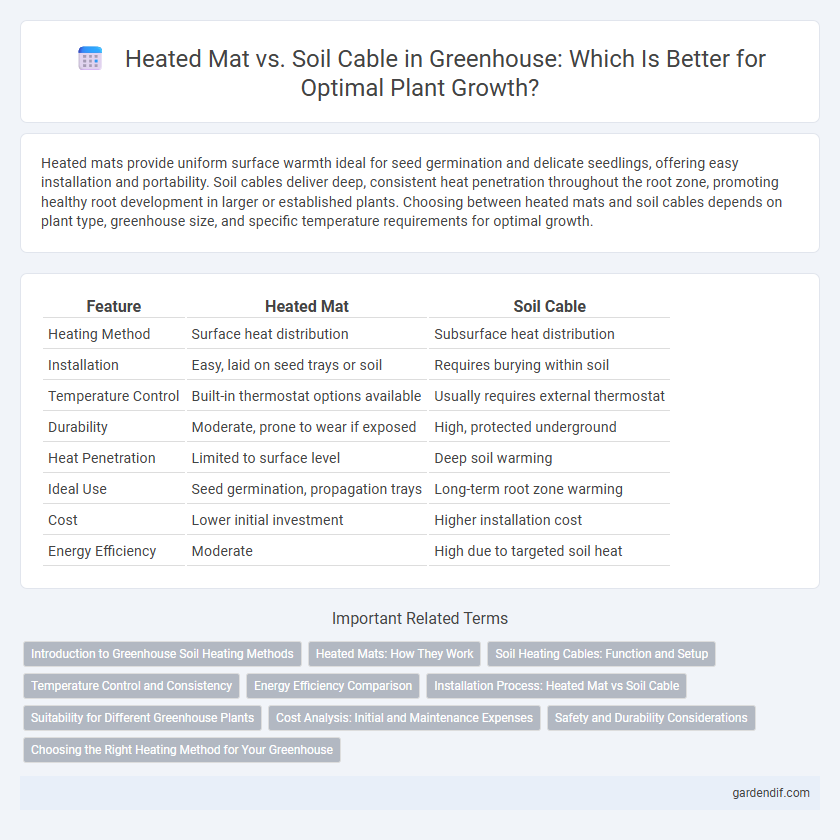
Heated Mat vs Soil Cable Illustration
Heated mats provide uniform surface warmth ideal for seed germination and delicate seedlings, offering easy installation and portability. Soil cables deliver deep, consistent heat penetration throughout the root zone, promoting healthy root development in larger or established plants. Choosing between heated mats and soil cables depends on plant type, greenhouse size, and specific temperature requirements for optimal growth.
Table of Comparison
| Feature | Heated Mat | Soil Cable |
|---|---|---|
| Heating Method | Surface heat distribution | Subsurface heat distribution |
| Installation | Easy, laid on seed trays or soil | Requires burying within soil |
| Temperature Control | Built-in thermostat options available | Usually requires external thermostat |
| Durability | Moderate, prone to wear if exposed | High, protected underground |
| Heat Penetration | Limited to surface level | Deep soil warming |
| Ideal Use | Seed germination, propagation trays | Long-term root zone warming |
| Cost | Lower initial investment | Higher installation cost |
| Energy Efficiency | Moderate | High due to targeted soil heat |
Introduction to Greenhouse Soil Heating Methods
Greenhouse soil heating methods primarily include heated mats and soil cables, each designed to maintain optimal root zone temperatures for plant growth. Heated mats offer a uniform, above-ground heat source ideal for seed germination and young seedlings, while soil cables are embedded within the soil to provide consistent, direct heat that penetrates deeper into the root zone. Both methods improve plant development and extend growing seasons by preventing soil temperature fluctuations and promoting healthier root systems.
Heated Mats: How They Work
Heated mats operate by evenly distributing warmth across their surface through embedded electrical coils, promoting faster seed germination and root development in greenhouses. These mats provide consistent bottom heat directly to plant trays or pots, optimizing soil temperature without overheating the surrounding air. Unlike soil cables, heated mats are portable and easy to install, offering efficient energy use and precise temperature control for delicate seedlings.
Soil Heating Cables: Function and Setup
Soil heating cables provide consistent underground warmth by emitting radiant heat directly to the root zone, enhancing seed germination and plant growth in cold conditions. These cables are installed in loops beneath the soil surface, often spaced evenly to ensure uniform temperature distribution and prevent overheating. Proper setup involves embedding the cable within a protective sleeve or conduit, connected to a thermostat for precise temperature control, optimizing energy efficiency and plant health.
Temperature Control and Consistency
Heated mats provide consistent and even heat distribution across the root zone, making temperature control more precise and stable for seedlings and plants in a greenhouse. Soil cables, while effective, tend to create localized hotspots and may require more monitoring to maintain uniform soil temperatures. The choice between heated mats and soil cables impacts overall plant health through the consistency and accuracy of temperature regulation in controlled greenhouse environments.
Energy Efficiency Comparison
Heated mats provide consistent warmth directly to seed trays with lower energy consumption, making them more efficient for small-scale greenhouse use. Soil cables, while delivering heat evenly throughout the soil, often require more energy due to their extensive layout and higher wattage. For optimal energy efficiency, heated mats are preferable in controlled zones, whereas soil cables suit larger areas but at a higher power cost.
Installation Process: Heated Mat vs Soil Cable
Heated mats offer a straightforward installation process, as they come in pre-formed sizes that can be easily laid out under seed trays or pots with minimal setup. Soil cables require more careful placement and securing within the soil, often necessitating trenching or embedding to ensure even heat distribution without damaging roots. Efficiency during installation favors heated mats, especially for small-scale or modular greenhouse setups.
Suitability for Different Greenhouse Plants
Heated mats maintain consistent surface warmth, making them ideal for seed germination and delicate seedlings that require gentle heat, such as tomatoes and peppers. Soil cables provide more uniform heat distribution throughout the root zone, benefiting larger, established plants like cucumbers and leafy greens that thrive in stable soil temperatures. Selecting between heated mats and soil cables depends on plant type, growth stage, and specific temperature needs within the greenhouse environment.
Cost Analysis: Initial and Maintenance Expenses
Heated mats typically have a lower initial cost compared to soil cables, making them a budget-friendly option for small-scale greenhouse setups. Soil cables, while more expensive upfront, offer greater durability and energy efficiency, which can reduce long-term maintenance and operational expenses. Considering both initial purchase and ongoing costs is crucial for optimizing the heating budget in greenhouse temperature management.
Safety and Durability Considerations
Heated mats offer a consistent surface temperature and typically include built-in thermostats, enhancing safety by preventing overheating and reducing fire risks compared to soil cables. Soil cables, while flexible and suitable for varied planting configurations, may require careful installation and monitoring to avoid exposed wiring damage and potential electrical hazards. For long-term durability, heated mats are generally more robust with waterproof designs, whereas soil cables need protective layering to withstand moisture and physical wear in greenhouse environments.
Choosing the Right Heating Method for Your Greenhouse
Choosing between a heated mat and soil cable depends on the type of plants and soil temperature consistency required in your greenhouse. Heated mats provide gentle, even warmth ideal for seed starting and small pots, while soil cables offer flexible installation and deeper soil heating suited for larger beds or root crops. Assess energy efficiency and plant heat tolerance to select the optimal heating system for maintaining healthy growth conditions year-round.
Heated Mat vs Soil Cable Infographic

 gardendif.com
gardendif.com